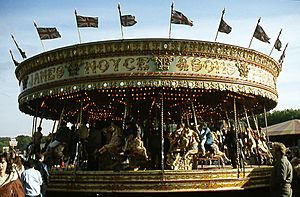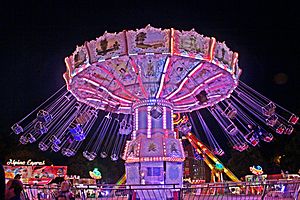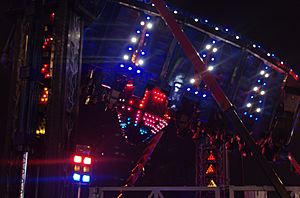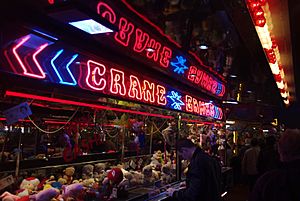Nottingham Goose Fair facts for kids
Quick facts for kids Nottingham Goose Fair |
|
|---|---|

Aerial view of Nottingham Goose Fair in 2007
|
|
| Genre | Fairground, funfair |
| Frequency | Annual |
| Location(s) | Forest Recreation Ground, Nottingham, United Kingdom |
| Years active | 741 years |
| Inaugurated | 1284 (Royal Charter) |
| Most recent | 30 September 2022 – 9 October 2022 |
| Next event | 2023 |
| Attendance | 420,000 (in 2019) |
| Capacity | Unlimited (at police discretion) |
| Patron(s) | Queen Camilla |
| Organised by | Nottingham City Council |
The Nottingham Goose Fair is a huge yearly travelling funfair held in Nottingham, England. It takes place at the Forest Recreation Ground during the first week of October. This fair is one of the oldest and largest in the United Kingdom. It is famous for its exciting rides and fun attractions.
The fair gets its name, "Goose Fair," from its early days. Back then, thousands of geese were brought from farms far away. They were sold in Nottingham at the fair each year. Today, the fair attracts over 400,000 visitors every year.
The fair's history goes back a long time. In 1284, King Edward I officially allowed city fairs in Nottingham. However, people believe a fair was already happening there even before that. The fair used to last eight days and started on September 21. In 1752, it moved to early October when Britain changed its calendar. For many centuries, the fair was held in Nottingham's Old Market Square. But in 1928, it moved to the larger Forest Recreation Ground. This move happened because the market square was getting too crowded.
The Goose Fair has been cancelled a few times in its long history. It was stopped in 1646 due to the bubonic plague. It was also cancelled during both World Wars. More recently, the fair did not happen in 2020 and 2021 because of the COVID-19 pandemic. In 2022, the fair was held for ten days, which was longer than usual.
Contents
History of the Goose Fair
How the Fair Started
No one knows exactly when the Nottingham fair first began. It has been around for many centuries, possibly even more than a thousand years. One of the earliest mentions of a "St. Matthew's Fair" in Nottingham is from Saxon times. This fair was held on September 21. It is also known that the Danes lived in Nottingham. They likely set up a market that might have included an early fair.
In the 1100s and 1200s, kings often gave special permission for fairs to be held. In 1284, King Edward I gave a special paper, called a royal charter, for a fair in Nottingham. This fair was to be held on St. Matthew's Day. Even though the charter was given then, it seems a fair was already popular in Nottingham.

The name "Goose Fair" first appeared in Nottingham records in 1541. It was called "Goose Fair Day." The name came from the thousands of geese that were walked from places like Lincolnshire and Cambridgeshire. These geese traveled fifty miles or more to be sold in Nottingham. To protect their feet on the long journey, the birds' feet were covered with a mix of tar and sand. Up to 20,000 geese were brought into Nottingham's Old Market Square. The fair was held there for hundreds of years. The geese were sold for a traditional meal called roast goose, eaten around Michaelmas (September 29). This date marked the end of the harvest season.
In 1752, the fair's start date changed from September 21 to the first week of October. This happened because Britain adopted the Gregorian calendar. To make this change, eleven days were skipped in September that year. So, the Goose Fair moved to October 2 and has stayed around that date ever since.
From Trade to Thrills
The Goose Fair began as a place to buy and sell goods. Besides geese and other animals, it was known for its excellent cheese. In 1766, there was a "cheese riot" because cheese prices went up a lot. People were upset about the high cost.
Over time, fun side shows were added to entertain the crowds. As transportation improved, people didn't need fairs as much to buy things from traveling merchants. So, the trade part of the fair became less important. Fairground rides started to take over. By the late 1800s, the Goose Fair had many rides. These included spinning gondolas, gallopers (merry-go-rounds), and even animal shows.
The fair grew so big that it spread into the streets around the Old Market Square. This caused a lot of traffic and crowding. In 1928, the fair moved to the Forest Recreation Ground. This new spot was more than twice the size of the market square. Even though some people worried about the move, it turned out to be a great new home for the fair.
Fair Cancellations and Changes
Nottingham's Goose Fair has not happened every single year. It was cancelled in 1646 because of the Great Plague. It was also stopped during World War I (1914–1918). During World War II (1939–1944), the fair was officially cancelled. However, it was held for a week in July 1943 and August 1944, but only during the daytime. This was because of wartime rules about darkness. The fair returned to its usual time in October 1945.
The length of the fair has changed over the years. It was originally eight days long. Later, it was shortened to three days. Then, in the early 1900s, it was extended to four days. In 2009, it became five days long. In 2022, it ran for ten days.
Modern Goose Fair Experience
Getting to the Fair

The Goose Fair happens every year at the Forest Recreation Ground. This location is about a mile north of Nottingham city centre. The fair takes up all the grassy areas and half of the car park. A large space next to the fairground is used by the show travelers. They set up their homes there for the fair's duration.
Special road rules are put in place during the fair. This helps traffic move smoothly. Parking is limited nearby, and public transport is encouraged. There are regular trams to the Forest Recreation Ground. Buses also go to nearby Mansfield Road.
Before the fair starts, a giant goose mascot appears. This mascot, named "Goosey," is 2 meters tall. It is placed on a roundabout near the fairground. This tradition began in the 1960s. The fair officially opens each year with a special ringing of silver bells. The Lord Mayor of Nottingham performs this ceremony.
Rides and Attractions
Nearly half a million people visit Nottingham's Goose Fair each year. Today, it is most famous for its many rides and games. There are over five hundred attractions. Some are for people who love thrills, and many are fun for the whole family.
For those who like adventure, there are rides like Speed XXL. This ride spins you around with strong forces. XLR8 is another spinning drum ride with even stronger forces. The Wild Mouse roller coaster is a fast roller coaster with spinning carts. The Reverse bungee shoots you high into the air using elastic ropes. Magic, a modern version of the Waltzer, first came to the fair in 2017. A huge swinging and spinning ride called the Giant Frisbee also arrived that same year.
There are many family-friendly attractions too. These include traditional bumper cars, helter skelters (slides), funhouses, ghost trains, teacups, and waltzers. You can also find many game stalls, like Hook-a-duck, where you can win prizes. A giant ferris wheel offers amazing views of the entire fair. You can also buy classic fair food. This includes hot dogs, candy floss, doughnuts, and mushy peas with mint sauce.
Goose Fair in Art and Stories
The Goose Fair has inspired many artists and writers.
- Nottingham artist Noel Denholm Davis painted Nottingham Goose Fair in 1910. This painting is now at the Nottingham Castle Museum and Art Gallery. Another Nottingham artist, Arthur Spooner, painted The Goose Fair, Nottingham in 1926. This painting was sold for a lot of money and is also at Nottingham Castle.
- The famous writer D. H. Lawrence visited the Goose Fair every year. In 1910, he wrote a short story called "Goose Fair." It was later included in his book, The Prussian Officer and Other Stories.
- In his novel Goose Fair, Cecil Roberts described the fair in a funny way. He wrote that people "take leave of their senses" at the fair. This book was published in 1928.
- English Journey by J. B. Priestley, published in 1934, talks about his travels in England. He described the Goose Fair as a "crushing mass of gaping and sweating humanity."
- The Goose Fair has appeared in movies like The Woman for Joe (1955), Saturday Night and Sunday Morning (1960), and Weekend (2011).
- The short story "Noah's Ark" by Alan Sillitoe (1991) is set at Nottingham's Goose Fair. The fair also appears in his novel "Saturday Night and Sunday Morning".
- Goose Fair Night is a book of poems from 2016 by Kathy Pimlott. It includes her thoughts on places in Nottingham, including the annual Goose Fair.
See also
- Bridgwater – has large annual funfair similar to Nottingham's Goose Fair
- Market town
- Peddler
- Renaissance fair
- Town privileges
Images for kids






